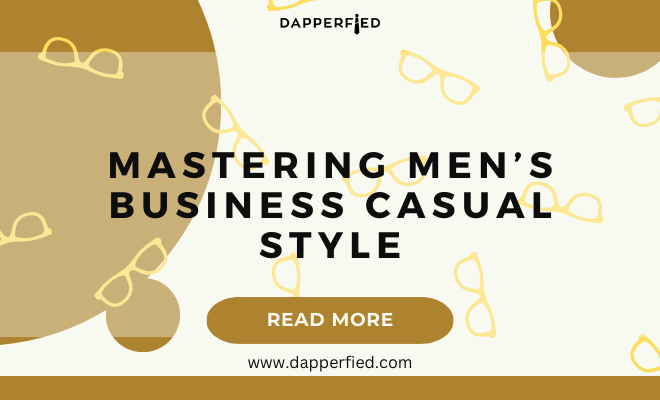
Men's Style
Mastering Men’s Business Casual Style
Business casual is a dress code that is commonly adopted in many workplaces. It is a step down from the traditional business professional attire, but still requires a polished and put-together look. Understanding the basics of business casual is essential for anyone looking to navigate this dress code with ease. Business casual typically includes a mix of formal and informal pieces, allowing for more flexibility and personal style expression. It is important to note that business casual can vary depending on the industry, company culture, and geographic location. While some workplaces may allow for more casual attire, others may have stricter guidelines for what is considered appropriate. Understanding the expectations of your specific workplace is crucial in mastering the art of business casual.
When it comes to business casual, it’s important to strike a balance between looking professional and feeling comfortable. This means opting for clothing that is more relaxed than traditional business attire, but still maintains a level of polish and sophistication. Business casual attire often includes pieces such as tailored trousers, dress shirts, blouses, skirts, and dresses. It is important to avoid clothing that is too casual or revealing, such as jeans, t-shirts, and sneakers. Instead, opt for clothing that is well-fitted and made from high-quality materials. Understanding the basics of business casual also means paying attention to details such as grooming and personal hygiene. While business casual allows for more freedom in clothing choices, it is still important to present a clean and well-groomed appearance in the workplace.
Key Takeaways
- Business casual is a dress code that combines professional and relaxed attire
- Key pieces for a business casual wardrobe include tailored trousers, blouses, and blazers
- Mixing and matching different pieces can create versatile business casual looks
- Accessories like statement jewelry and scarves can elevate a business casual outfit
- Do’s include wearing well-fitted clothing, while don’ts include wearing overly casual or revealing items
Choosing the Right Pieces for a Business Casual Wardrobe
When building a business casual wardrobe, it’s important to choose the right pieces that will allow for versatility and flexibility. Investing in classic and timeless pieces is key to creating a wardrobe that can easily transition from the office to after-work events. For men, this may include items such as tailored trousers, dress shirts, blazers, and loafers. For women, key pieces may include tailored trousers, blouses, pencil skirts, and classic pumps. When choosing pieces for a business casual wardrobe, it’s important to consider the fit, fabric, and overall quality of the clothing. Opting for well-made pieces that fit properly will ensure a polished and professional look.
In addition to classic pieces, incorporating some modern and trendy items can help add personality and style to a business casual wardrobe. For men, this may include adding a pop of color with a statement tie or pocket square. For women, incorporating accessories such as statement jewelry or a bold handbag can help elevate a business casual look. When choosing the right pieces for a business casual wardrobe, it’s important to consider the specific dress code of your workplace and the industry in which you work. While some workplaces may allow for more creativity and individuality in clothing choices, others may have stricter guidelines for what is considered appropriate. Understanding the expectations of your workplace will help guide you in choosing the right pieces for your business casual wardrobe.
Mixing and Matching Business Casual Pieces
One of the key benefits of a business casual dress code is the ability to mix and match different pieces to create a variety of looks. This allows for more creativity and personal style expression in the workplace. When mixing and matching business casual pieces, it’s important to consider color coordination, proportions, and overall balance in the outfit. For example, pairing a tailored blazer with a pair of tailored trousers can create a polished and professional look for both men and women. Mixing different textures and patterns can also add visual interest to an outfit while still maintaining a professional appearance.
Another way to mix and match business casual pieces is by incorporating different layers into an outfit. For men, this may include layering a dress shirt with a sweater or cardigan. For women, layering a blouse with a blazer or cardigan can create a sophisticated and stylish look. Mixing and matching business casual pieces also allows for more versatility in the wardrobe, as different combinations can be created for various occasions and events. This can help reduce the need for constantly purchasing new clothing items, as existing pieces can be styled in different ways to create new looks.
Incorporating Accessories into Your Business Casual Look
| Accessories | Benefits |
|---|---|
| Statement necklace | Adds a pop of color and personality |
| Watch | Polishes the look and adds a professional touch |
| Scarf | Provides warmth and adds texture to the outfit |
| Belt | Defines the waist and adds structure to the outfit |
Accessories are an essential part of any business casual wardrobe, as they can help elevate an outfit and add personality to a look. When incorporating accessories into a business casual look, it’s important to strike a balance between adding interest to an outfit without overpowering it. For men, this may include adding accessories such as a watch, tie clip, or pocket square to complement their outfit. For women, incorporating accessories such as statement jewelry, scarves, or a structured handbag can help add a touch of sophistication to a business casual look.
Choosing the right accessories for a business casual outfit also means paying attention to the overall aesthetic and style of the workplace. While some workplaces may allow for more creativity and individuality in accessory choices, others may have stricter guidelines for what is considered appropriate. Understanding the expectations of your workplace will help guide you in choosing the right accessories for your business casual look. When incorporating accessories into a business casual outfit, it’s important to consider the overall balance and proportion of the outfit. Opting for accessories that complement the clothing without overpowering it will ensure a polished and professional appearance.
Navigating the Do’s and Don’ts of Business Casual
Navigating the do’s and don’ts of business casual can be challenging, as it requires finding the right balance between looking professional and feeling comfortable. One of the key do’s of business casual is to opt for clothing that is well-fitted and made from high-quality materials. This means avoiding clothing that is too tight or too loose, as well as opting for fabrics that are wrinkle-resistant and durable. Another do of business casual is to pay attention to grooming and personal hygiene. While business casual allows for more freedom in clothing choices, it is still important to present a clean and well-groomed appearance in the workplace.
On the other hand, there are also several don’ts when it comes to navigating business casual. One of the key don’ts is to avoid clothing that is too casual or revealing, such as jeans, t-shirts, and sneakers. While some workplaces may allow for more relaxed attire, it’s important to err on the side of caution and opt for clothing that maintains a level of polish and sophistication. Another don’t of business casual is to avoid over-accessorizing or wearing accessories that are too flashy or distracting. Choosing accessories that complement an outfit without overpowering it will ensure a polished and professional appearance in the workplace.
Tailoring Your Business Casual Look to Your Workplace

Tailoring your business casual look to your workplace is essential in ensuring that you are meeting the expectations of your specific dress code. This means paying attention to the industry, company culture, and geographic location of your workplace when choosing clothing items and styling outfits. For example, if you work in a creative industry such as advertising or fashion, you may have more freedom in expressing your personal style through clothing choices. On the other hand, if you work in a more conservative industry such as finance or law, you may need to opt for more traditional and classic pieces that maintain a professional appearance.
When tailoring your business casual look to your workplace, it’s important to pay attention to the specific guidelines and expectations set by your employer. Some workplaces may have strict dress codes that outline what is considered appropriate attire, while others may have more relaxed guidelines that allow for more creativity and individuality in clothing choices. Understanding the specific expectations of your workplace will help guide you in tailoring your business casual look to ensure that you are presenting a polished and professional appearance.
Mastering the Art of Confidence in Business Casual Style
Mastering the art of confidence in business casual style is essential in exuding professionalism and authority in the workplace. Confidence is key in carrying off any outfit with style and grace, and this holds true for business casual attire as well. One way to master confidence in business casual style is by choosing clothing that makes you feel comfortable and empowered. When you feel good in what you’re wearing, it shows in your posture and demeanor, ultimately boosting your confidence.
Another way to master confidence in business casual style is by paying attention to grooming and personal hygiene. Ensuring that you are well-groomed and presentable will not only make you feel more confident but will also leave a positive impression on others in the workplace. Additionally, mastering confidence in business casual style means carrying yourself with poise and professionalism. This includes maintaining good posture, making eye contact, and speaking with clarity and confidence.

In conclusion, understanding the basics of business casual is essential for anyone looking to navigate this dress code with ease. Choosing the right pieces for a business casual wardrobe involves investing in classic and timeless pieces while also incorporating modern and trendy items for added style expression. Mixing and matching business casual pieces allows for versatility in creating different looks while incorporating accessories helps elevate an outfit and add personality. Navigating the do’s and don’ts of business casual requires finding the right balance between looking professional and feeling comfortable while tailoring your business casual look to your workplace ensures that you are meeting specific dress code expectations. Finally, mastering confidence in business casual style involves feeling comfortable and empowered in what you’re wearing while paying attention to grooming and personal hygiene and carrying yourself with poise and professionalism.
Looking to upgrade your business casual wardrobe? Check out our article on creating a versatile capsule wardrobe for men, featuring essential jackets that will elevate your style game. Whether you’re aiming for a polished office look or a smart-casual ensemble for after-work events, having the right jackets in your collection is key. Learn more about building a functional and stylish wardrobe by visiting Dapperfied’s guide to men’s capsule wardrobe jackets.
FAQs
What is considered men’s business casual style?
Men’s business casual style typically includes a combination of dress pants, a button-up shirt, a belt, and dress shoes. It may also include a blazer or sport coat, but does not require a full suit.
Can men wear jeans in a business casual setting?
In some business casual settings, men may be allowed to wear dark-colored, well-fitted jeans. However, it’s important to check the specific dress code of the workplace or event to ensure that jeans are appropriate.
What type of shoes are appropriate for men’s business casual style?
Appropriate shoes for men’s business casual style include loafers, oxfords, derbies, and dress boots. It’s important that the shoes are clean, polished, and in good condition.
Are ties necessary for men’s business casual style?
Ties are not always necessary for men’s business casual style, but they can be added to elevate the look. In some workplaces, a tie may be required for certain meetings or events.
Can men wear polo shirts in a business casual setting?
In some business casual settings, men may be allowed to wear polo shirts. However, it’s important to ensure that the polo shirt is in good condition, well-fitted, and paired with appropriate pants and shoes.














